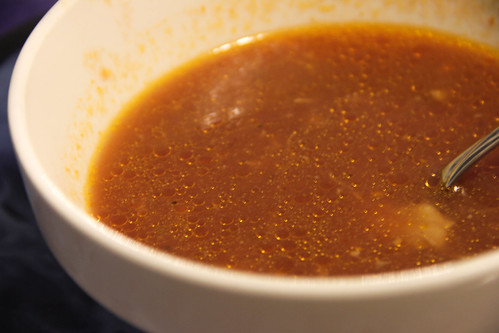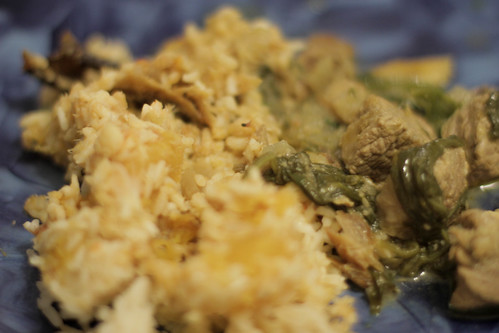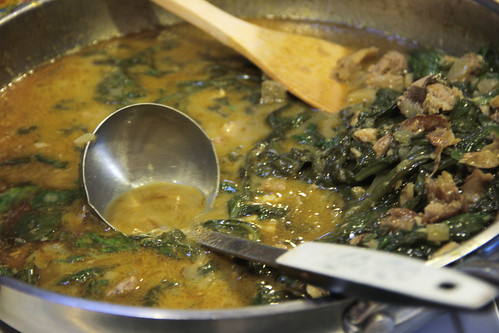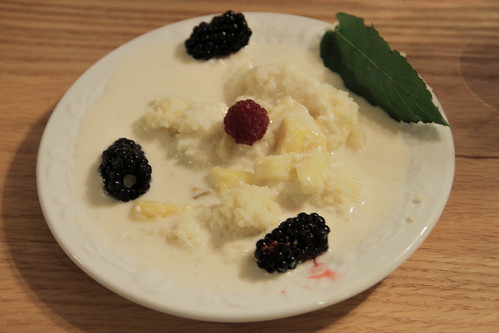“In the center of Tbilisi, the capital, there is a statue of a woman with a sword in one hand, and wine in the other. It shows how, if you come in war, the Georgians are so fierce the women as well as the men will fight you. But if you come in peace, you’re invited to feast.” Throughout the evening, on our friend Mark’s rooftop in Williamsburg, was punctuated by two periodic events: the rumbling of the elevated J train a few feet away, and stories from Mark, our tamada -- toastmaster -- as well as host.

Time spent in Georgia qualified Mark to guide our meal; having attended a supra, a feast, with President Saakashvili lent him all the more authority to regale us with tales of strength, folly, and complexity, usually leading to a moral and always finished with a toast. These stories of a distant and ancient land, washed down with abundant wine, enriched the meal nearly as much as the walnuts, herbs, and spices.

Even if you don’t have a tamada from Tbilisi to guide your meal, do yourself a favor and get to know Georgian food. Despite its history as a former Soviet republic -- and homeland of Joseph Stalin! -- it has nothing to do with sour creamand pickled fish! Its cuisine is much closer to Persian and Central Asian, overflowing with vegetables, nuts, fresh flavors, and a wide variety of meats. The cuisine is most authentically enjoyed in abundance: Mark’s a generally easygoing guy, so I took it quite seriously when he warned me that if the table were anything short of crammed full of food, it’d be a failure.

Enormous thanks to Justin and Kathryn, who braved a hot and small kitchen to make this absurdly ambitious feast get started before sunset!
Note that we put all the food out on the table at once, so rather than a list of courses, I’ve ordered these roughly in the order in which I prepared them.
Tarkhun | Tarragon drink | Recipe

Georgian cuisine is huge on spices and especially herbs. Whether dried or fresh, just about every recipe is enhanced with flavors from either the backyard or the trade caravan. In fact, Georgians are so crazy about their herb flavors that they even drink them, as evidenced by this drink made of tarragon. It’s quite an experience to drink in the essence of an herb, and we picked up a milky aspect along with the particular clear intensity that makes tarragon so lovely. (Note, also, that this is the first Nosh in which I used food coloring! Had to make it authentic, right?)
Pkhali | Spinach-walnut paste | Recipe
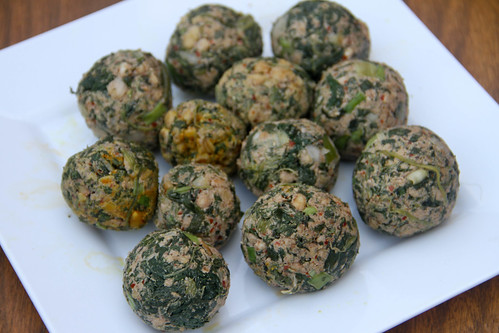
It’s a shame I couldn’t find pomegranate in the supermarket, because these nuggets would have looked even lovelier with the particular topping. Anyway, if I had to choose a dish that captured the essence of Georgian cuisine, I’d probably go with pkhali. It has the ubiquitous walnuts, leans heavily on fresh vegetables, and incorporates a whole lot of herbs and spices. It’s also a devil of a name to pronounce! I found pkhali pretty intense, though when I reread the recipe I saw that it’s intended to be spread on bread rather than eaten straight, which makes a whole lot of sense.
Khachapuri | Cheese bread | Recipe
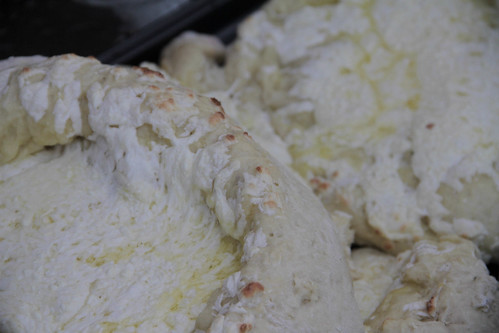
If pkhali is the most representative of Georgian cuisine, khachapuri is arguably the best-known and definitely was the crowd favorite. It’s essentially pizza without the tomato sauce: a bready boat-shaped dough with a filling of sulguni cheese (kinda like mozzarella but marinated in brine), butter, and egg. There are several versions of khachapuri, this one, known as Adjarian, is supposed to have a barely-cooked egg sitting on top so you can dip the edges into the yolk, but time and logistical difficulties made that impossible. The crowd didn’t seem to mind, in fact I didn’t make nearly enough to satisfy demand! You can probably find sulguni at a Russian or Eastern European market, otherwise you could probably use mozzarella or a stringy Mexican cheese like oaxaca. You just might want to salt the filling a bit more to compensate for the lack of brine.
Shotispuri | Baton bread | Recipe

I figured it’d be nice to have some bread to go with all we were having, and this baton-shaped bread was nice enough, I guess, but not worth the effort. My advice would be to just focus on the khachapuri, it’d be nearly impossible to make too much of it.
Badrijani Nigvzit | Fried eggplant rolls with garlic-walnut filling | Recipe
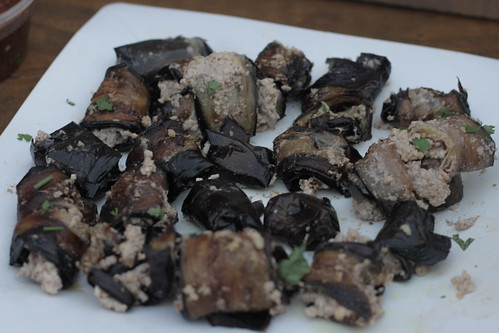
Wow, these were tasty. Garlic and walnuts are an unexpected but great combination, sharp and brash versus meaty and deep. Put that inside strips of eggplant fried dark brown. Who doesn’t like intense flavors wrapped fried things? A real winner, this would make for a great potluck dish. You could replace the fried eggplant strips with marinated peppers or even strips of cucumber if you wanted to avoid the calories and hassle of the eggplant.
Satsivi | Roast chicken with walnut sauce | Recipe
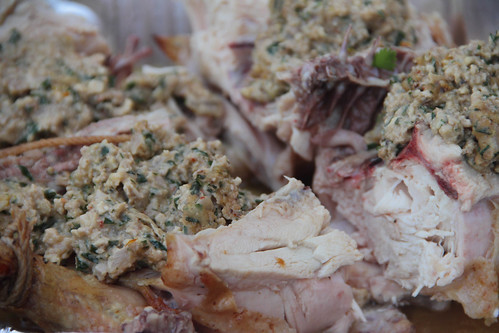
There’s two genius things going on with this recipe. First off, this is the best advice for roasting a chicken I’ve ever read. Trussing is actually pretty easy -- no needle needed, just about three feet of twine to tighten up the bird. The genius, though, is roasting on high heat for ten minutes on each side, like, thigh to the bottom of the pan, then returning to legs-up for the last 40 minutes at regular heat. The result was a perfectly cooked bird. Oh, and the butter basting helped.
I’d have been happy just to tuck into that well-roasted chicken, but the sauce made it sublime. It’s essentially pounded walnuts (walnuts! again!) with onion, a little flour to thicken, and chicken stock, reduced until you can just about slather it over the chicken. I’m pretty sure I’ll make this rich and oh-so-tasty dish again. Bonus: it’s just as good cold as it is hot.
Chakhokhbili | Braised chicken and tomato | Recipe

While the summer doesn’t afford pomegranates, it sure offers tomatoes, and this is a great alternative if you’re looking for something to do with the abundance in your garden or farmer’s market and don’t want to make pasta sauce. This recipe is so easy you can practically tweet it: brown the chicken legs, add an onion, add a lot of tomatoes, braise until meat’s falling off the bones, throw in herbs, serve. The braising makes this take longer you want for an easy after-work supper, but it’s not a lot of work, so if you have the time, treat yourself! (Thanks to Kathryn for chopping all those tomatoes!)
Lobio | Kidney bean salad | Recipe
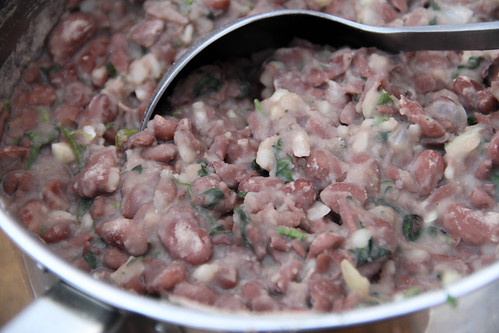
It says something about Brooklyn that I couldn’t find a simple bag of dry kidney beans in the two food shops closest to my house, but both of them had several types of quinoa. When I made it over to Mark’s, his roommate Justin volunteered to go to the supermarket down the block to get some, and he was so happy to find it he bought two bags. So we made a lot of this salad. It was pretty good, but not particularly awesome; perhaps in the rush to finish up the meal we accidentally missed a spice or put in too little onion.
Khinkali | Georgian “soup” dumplings | Recipe

I think I’m getting better at my kitchen pacing, after so many meals, but I waited too long to get start started on this dish, the quintessential Georgian accompaniment to beer. (Or is it that beer is the quintessential accompaniment to khinkali?). I don’t like making things with rolled-out dough, and I didn’t have a scale on me and the recipe was all based on weight so I had to completely wing the proportions, and ended up making too little dough. Then when it came to making what are supposed to be cute little meat-filled parcels, they looked pretty ugly, too small -- and then when boiled, many of them broke instead of keeping the juiciness from the cooked meat within. So the dumplings came out late, were misshapen, and there were too few. Oh well, it was worth a try, but I gotta get better at my dumpling-making because so many cultures do this sort of thing. Any tips?
Shashlik | Barbecue | Recipes: marinade, savory sauce, hot sauce
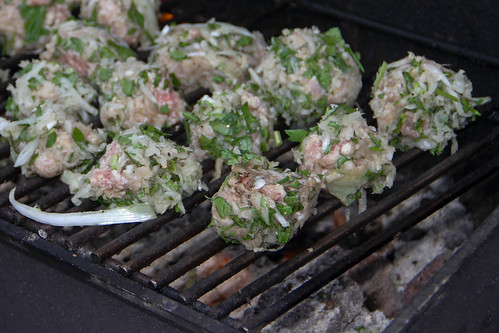
This was the other major screw-up -- I misread the recipe when making my shopping list and got ground lamb instead of chunks! I made the most of the situation by forming the ground lamb into balls, and marinating it in the copious quantity of onions as specified. (Thank goodness for the food processor, shredding 2.5 pounds of onions by hand would have been brutal.) I asked Kathryn to put them on the kabob skewers, but that quickly proved to be impossible, so we instead threw them on the grill directly -- and, despite being completely the wrong format, they were delicious. Several sauces accompanied: an herb-and-tomato sauce, a hot sauce (I used those fat red peppers rather than jalapenos as specified), and a bottled sour plum sauce.
Ghvinisa da tsqlis | Wine and water

Along with the tarragon drink, we washed the food down with Borjomi, a fairly salty mineral water with reputed health benefits, and of course plenty of wine. Georgia’s been making wine for millennia, but apparently the quality took a big hit in the Stalin years. Uncle Joe, as they call him, was actually a big promoter of Georgia’s wine, but his preference was for sweet wine, so they made sweet wine. It’s only in recent years that drier, more complex wines have come to market -- and, in fact, some of them are quite good, definitely fruity and with a moderate terroir. Don’t be surprised if you see a Georgian wine or two at your local wine shop one of these days, because we found one at ours! While our preference was for red, you just might see a special wine called Pheasant's Tears, which is called "amber," distinctively yellower than white wine.
Laura keeps a list of countries that weren’t really on her radar but that she’s now interested to visit after eating the food -- Cape Verde, Comoros...and now Georgia! Coming up is a swing of the pendulum, a cuisine that's familiar yet rather ignored in the culinary canon: Germany.
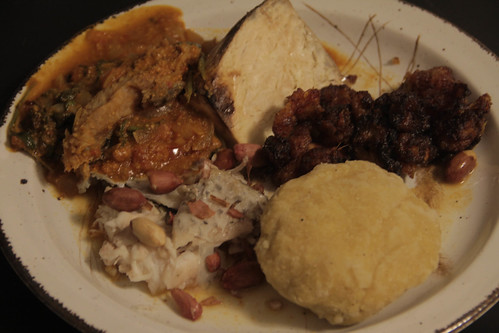 When I asked for fermented cornflour at Owa Afrikan Market, the kindly shopkeeper replied, "Kenkey? Oh, that's from Ghana. We're a Nigerian store!" I didn't have much better luck at Diaby African Market, which is run by shopkeepers from Cote d'Ivoire who are equally friendly but equally devoid of kenkey. Just as I'd begun to grow a bit fatigued of what seem to be a limited range of very common African staples -- smoked fish, palm oil, cassava, yam, plantain, peanuts -- I was so happy to discover first-hand some real regional variation that I quickly overcame the disappointment of not finding what I was looking for. (Plus, as you'll see below, I got creative and found my way around it.)
When I asked for fermented cornflour at Owa Afrikan Market, the kindly shopkeeper replied, "Kenkey? Oh, that's from Ghana. We're a Nigerian store!" I didn't have much better luck at Diaby African Market, which is run by shopkeepers from Cote d'Ivoire who are equally friendly but equally devoid of kenkey. Just as I'd begun to grow a bit fatigued of what seem to be a limited range of very common African staples -- smoked fish, palm oil, cassava, yam, plantain, peanuts -- I was so happy to discover first-hand some real regional variation that I quickly overcame the disappointment of not finding what I was looking for. (Plus, as you'll see below, I got creative and found my way around it.)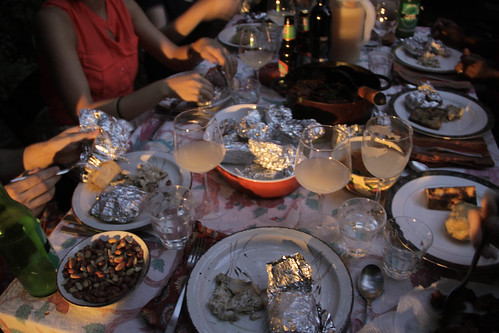
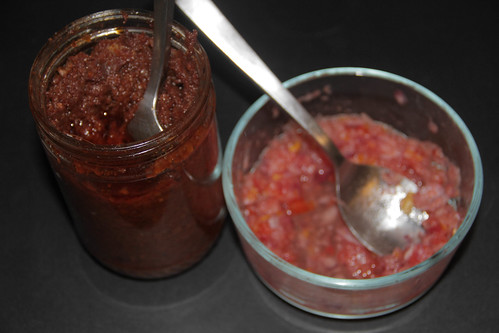


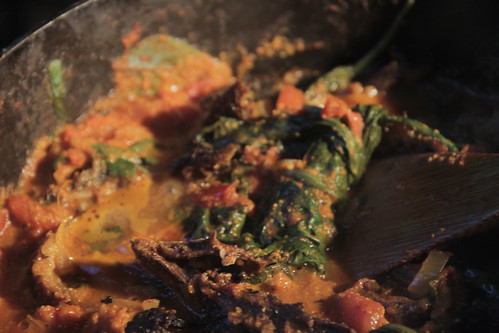
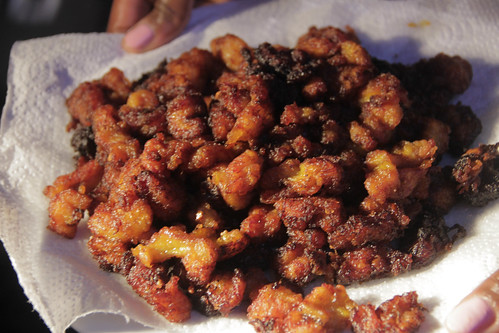
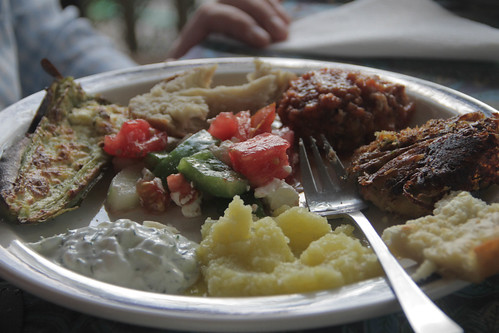

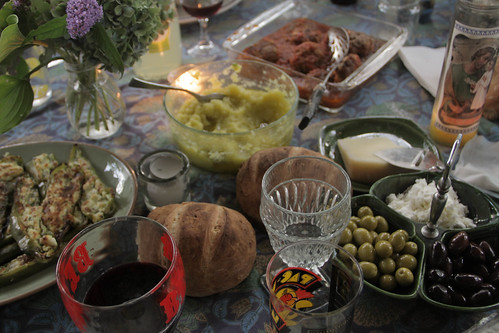
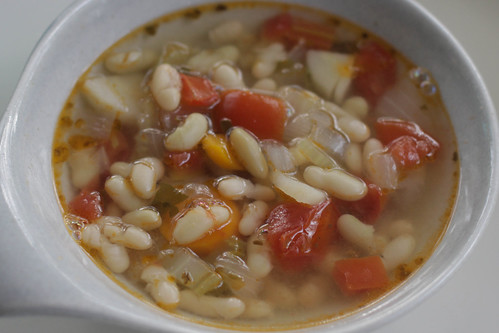
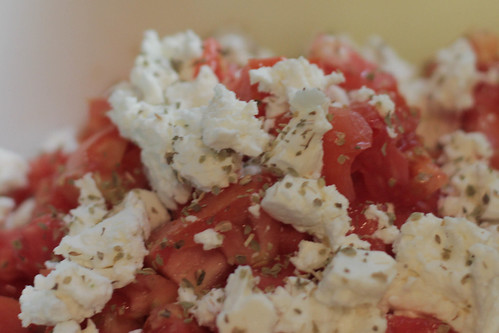
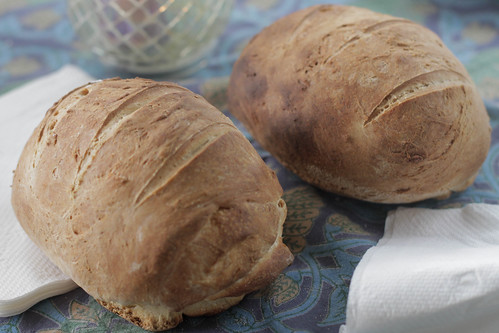
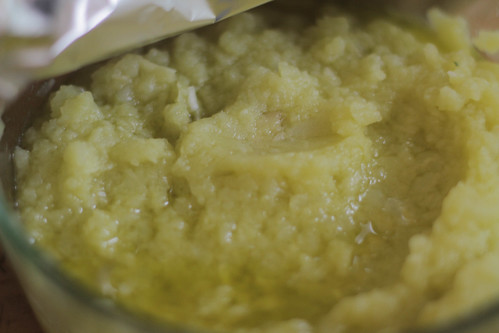
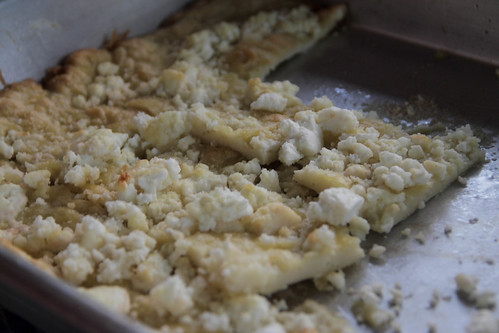
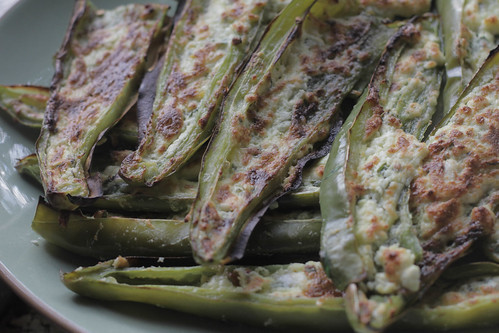

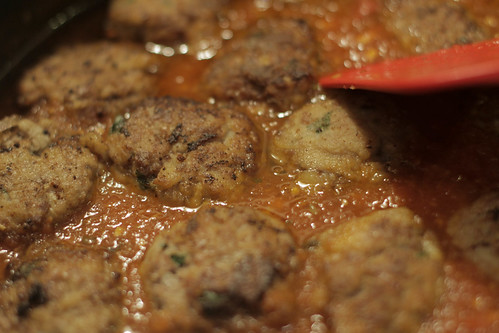
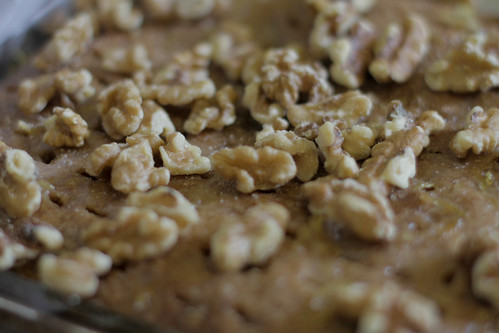
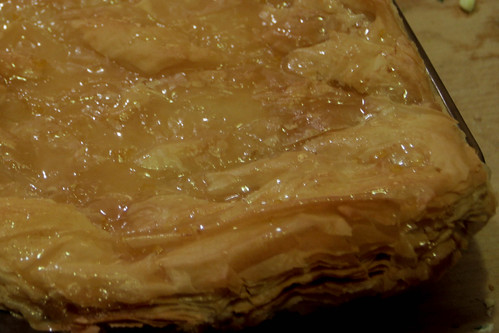
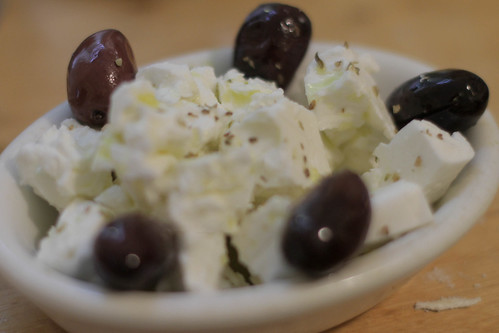

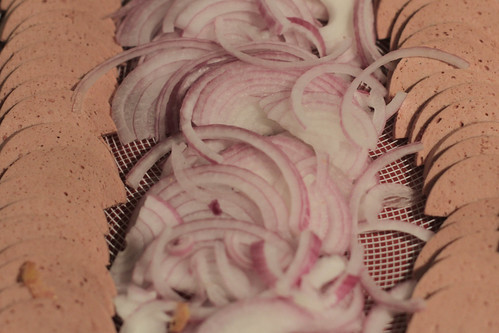

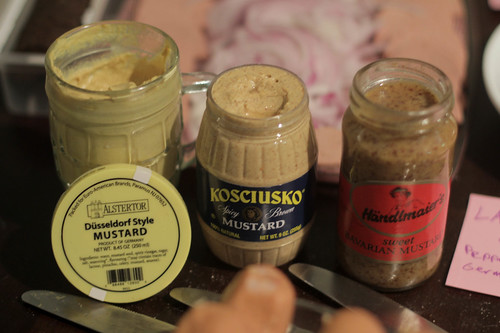
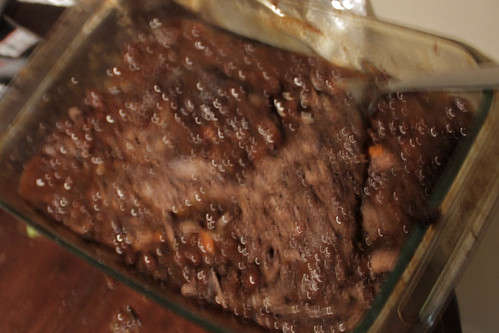


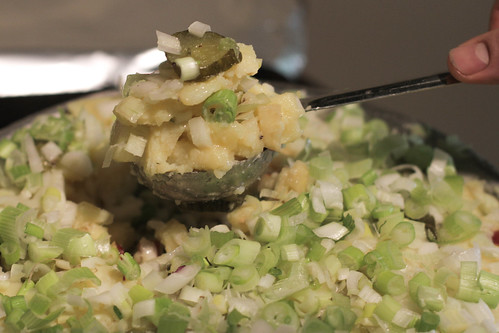
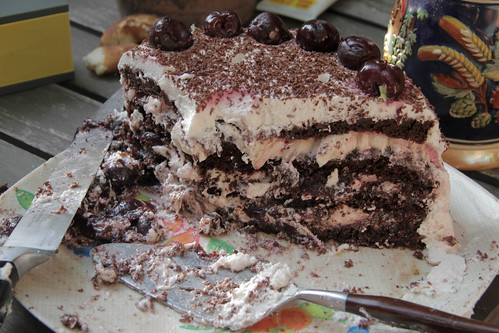














 The Gambia, a former British West African colony, is a little sliver of a country, hugging a river of the same name and surrounded by the formerly French Senegal. I find it appropriate that we held this Nosh in Portland, Oregon, a riverine city -- and, thankfully, one that has a few African markets!
The Gambia, a former British West African colony, is a little sliver of a country, hugging a river of the same name and surrounded by the formerly French Senegal. I find it appropriate that we held this Nosh in Portland, Oregon, a riverine city -- and, thankfully, one that has a few African markets!
